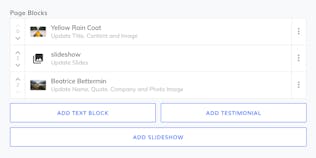Managing complex content with Array Structures
 By Mike Neumegen
·
22 May 2019
By Mike Neumegen
·
22 May 2019

At CloudCannon, we're always looking for ways to offload content management from developers and empower editors to make changes themselves. Enabling editors to build their own pages with complex elements such as slideshows, testimonials and call to actions is something we've wanted to support but haven't had a good solution for.
Using the Visual Editor or Content Editor for these complex elements can work, but don't provide any structure resulting in editors creating inconsistent and hard to maintain pages.
Using a front matter array is another implementation we've seen but suffers from the opposite problem of being too rigid. By default you can only have one type of structure in an array so it's difficult to support adding both slideshows and testimonials for example.
With Array Structures, editors have the best of both worlds. They have the freedom to create pages using multiple predefined elements the developer has setup and a rigid structure making the pages consistent and easy to maintain.
What are Array Structures?
Array Structures are simply front matter arrays with special configuration to define content types. Developers create templates for different types of content. Editors use these templates like building blocks to create their own pages.
How do developers setup Array Structures?
To begin, create an empty array to store the content in, page_blocks in the example below.
Next, we'll configure content types for page_blocks using the _array_structures key. You can think of these content types as the template for when an editor adds a new item.
Each type has a label and icon to help identify it in CloudCannon, and a value which is used to populate page_blocks when the editor adds a content type in CloudCannon.
In this example we've set an _id for each content type. This isn't required and isn't a special field, we'll use it later to identify the content type when we're iterating over the array for output.
For a more detailed explanation of configuring Array Structures, check out out the documentation.
page_blocks: []
_array_structures:
page_blocks:
values:
- label: Text Block
icon: ballot
value:
_id: text_block
title:
content_markdown:
image:
- label: Testimonial
icon: format_quote
value:
_id: testimonial
name:
quote:
company:
photo_image:
- label: Slideshow
icon: collections
value:
_id: slideshow
slides: []
slides:
values:
- label: Slide
icon: collections
value:
image:
caption:How do editors use Array Structures?
Editors manage content in Array Structures just like a normal front matter array. They can remove, reorder or edit existing items. The only difference is they have multiple options to add new items to the array:

Adding a new item copies the value from the Array Structure and populates a new item in page_blocks. Editors then add their content to the structured interface:

Once saved, the source code for the array contains the various content types:
page_blocks:
-
_id: text_block
title: Yellow Rain Coat
content_markdown: >-
Stand out from the crowd this winter with a stylish jacket. Protects you
from the elements, keeps you dry and fashionable, what more could you
want?
image: /uploads/thom.jpg
-
_id: slideshow
slides:
- image: /uploads/sharon.jpg
caption: Women in rain coat
- image: /uploads/pascal.jpg
caption: Man in raincoat
-
_id: testimonial
name: Beatrice Bettermin
quote: I love these rain coats
company: Raincoat Review Company
photo_image: /uploads/beatrice.jpgOutput
The final step is to iterate over the page_blocks array to output the content on the page. You can do this however you'd like. We find using a case statement on an _id field and having an include for each type the cleanest option.
{% for block in page.page_blocks %}
{% case block._id %}
{% when 'text_block' %}
{% include text-block.html block=block %}
{% when 'testimonial' %}
{% include testimonial.html block=block %}
{% when 'slideshow' %}
{% include slideshow.html block=block %}
{% endcase %}
{% endfor %}Having an include for each content type makes it easy to maintain and iterate on in the future:
<div class="testimonial">
<blockquote>
<p>{{ include.block.quote }}</p>
</blockquote>
<div class="person">
<h3>{{ include.block.name }}</h3>
<h4>{{ include.block.company }}</h4>
<div class="author-image">
<img src="{{ include.block.photo_image }}" alt="{{ include.block.name }}">
</div>
</div>
</div>Summary
Array Structures open a wealth of opportunities to empower editors to build complex pages. We'd love to hear about how you're using them!
Launch your website today
Give your content team full autonomy on your developer-approved tech stack with CloudCannon.
You might also like:

How to manage hundreds of connected websites with a Git-based headless CMS
Liam Bigelow
·
David Large
28 Mar 2024

